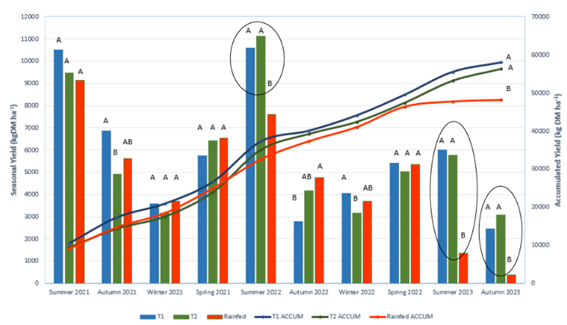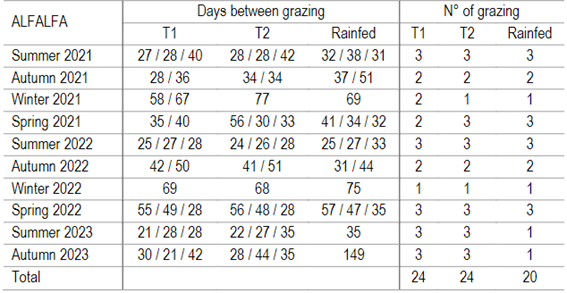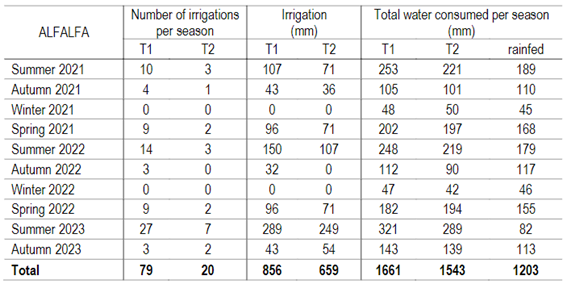1. Introduction
In recent years, there has been a rapid expansion of irrigation in dairy and intensive livestock farming, which traditionally relied on rainfed production1, aiming to mitigate the negative effects of climate change, particularly droughts, which have significantly impacted these productive sectors. In this new context, it is essential to define technical coefficients for the correct management of irrigation in pastures, which achieves the best balance between improving productivity and pasture quality and increasing costs due to the inclusion of irrigation, without affecting the sustainability of natural resources.
In the Uruguayan summer, it is common that the effective precipitation does not meet crop demand due to the high atmospheric demand and the low storage capacity of the soils, leading to low summer dry matter production in forage species. In addition, the interannual variability of precipitation and the gradual increase in the frequency of extreme events contribute to a lack of stability in dry matter production between years.
Alfalfa (Medicago sativa L.) is a legume that responds well to irrigation2, with reported international yields ranging from less than 1 t DM ha-1 in rainfed systems with low annual precipitation (<300 mm year-1), to more than 24 t DM ha-1year-1 in deep soils and good water availability 3)(4) 5. However, it is a species reported by other authors6 as moderately tolerant to water deficit. When maximum evapotranspiration (ETm) is 5 to 6 mm day-1, about 50% of the total water availability in the soil can be depleted without affecting crop evapotranspiration (ETc)7. On the other hand, alfalfa is more sensitive to saturated soils than other forage species, such as grasses, and when subjected to waterlogging conditions for more than 7 to 14 days, root death and fungal infections such as Phytophthora 6)(8) can occur. Alfalfa development is affected by thermal stress, with lower (Tb) and upper (TB) base temperatures of between 5 and 45 °C, respectively. Between these temperatures, the development rate of alfalfa increases linearly, reaching a maximum of 30 °C (optimal temperature)9.
In Uruguay, alfalfa is destined for cutting and grazing. In grazing management, crop production may be affected by the mechanical action of animals, and there could be an impact on the soil's physical properties in the long term. Therefore, it is important to evaluate forage production under grazing conditions so that the result can be extrapolated to pastoral production systems and involve the effect of trampling combined with irrigation on the physical properties of the soil. There is conflicting information on the effect of grazing as a modifying agent of soil physical properties. Denoia and others10 indicated that direct grazing increased the bulk density (DAp) of the soil and decreased the infiltration rate. Arranz and others11 reported an increase in DAp caused by a decrease in macroporosity and an increase in microporosity, which could limit soil water availability. However, Kiessling and others12 were able to determine that animal trampling alone would not modify bulk density or total porosity. Alterations in soil properties could be more significant in irrigated pastures due to the high moisture content13.
This study aimed to define an irrigation management strategy for alfalfa that achieves a differential yield in the dual condition of irrigation and grazing, with a better use of rainfall, by evaluating soil physical properties.
2. Materials and methods
2.1 Experimental site
The trials were installed in the experimental field of the Agronomy College, South Regional Center, Canelones, Uruguay (34°37' S and 56°13' W) between 2020 and 2023. The predominant soil is a typic Eutric Brunosol Lac., from the Tala Rodriguez Soil Unit, corresponding to typic Argiudoll according to the USDA taxonomic classification. Table 1 presents information on its hydric properties.
Table 1: Physical and hydric characteristics of the soil
| Depth cm | FC vol% | PWP vol% | DAp gr cm-3 | AW mm/horiz |
| 0-19 | 44.9 | 27.4 | 1.15 | 33.0 |
| 20-36 | 45.6 | 27.7 | 1.20 | 28.6 |
| 37-80 | 43.2 | 25.9 | 1.20 | 74.1 |
FC: Field Capability; PWP: Permanent Wilting Point; DAp: bulk density; AW: Available water; vol%: Percentage in volume
2.2 Climate characterization
To characterize the climate during the experimental years, the period corresponding to the spring, summer, and autumn months was analyzed for a 36-year historical series (1988-89 to 2022-23) of ETo (atmospheric demand) and precipitation data, from the INIA Las Brujas agrometeorological station (34° 40' S, Longitude: 56° 20' W, Height: 32 masl). The ranking of the three years of evaluation (from 01/09/2020 to 31/05/2021; from 1/09/2021 to 31/05/2022, and from 1/09/2022 to 31/05/2023) within the series was determined.
2.3 Experimental design
The experimental design was a randomized complete block design, with three treatments and four replications. The plots were 11 × 11 m, with no space between plots to avoid edge effects that would alter the microclimatic conditions within the trial (oasis effect). The total experimental area was 1452 m².
The treatments were: T1: frequent irrigation, irrigation is carried out when 30% of the available water is depleted; T2: spaced irrigation, irrigated when 65% of the available water is depleted; T0: rainfed, receives only rainwater.
2.4 Irrigation management
To facilitate irrigation management and to avoid damage caused by animal entry, the irrigation equipment was installed underground with turbine sprinklers, pop-up sprinklers, and sectorial sprinklers regulated with a 90° angle (K-Rain brand, RPS 75 model), placed in each corner of the plots. In this way, the wet area during irrigation of each treatment did not affect the plots of other treatments. The irrigation application rate was 5.5 mm h-1.
To determine the irrigation time for each treatment, a daily water balance was carried out and soil moisture was measured before irrigation with FDR probe (Delta T Devices, PR2) to verify the threshold of irrigation treatments. Access tubes were placed in each evaluation plot and the calibration performed in previous studies14 with the gravimetric method was used for each horizon. The irrigation treatments began in November 2020.
The timing of irrigation was determined based on the accumulated deficit for each treatment. For its estimation, the available water at root depth and the depletion threshold of each treatment were considered (Eq. 1 and Eq. 2).
Where: Di-1 = accumulated deficit of the previous day; ETc = evapotranspiration of alfalfa; Ri = irrigation from the previous day; PPef = precipitation until reaching Field Capacity.
Based on the available water (AW) of the soil up to 40 cm of root depth, where the absorbing roots are concentrated, an accumulated deficit of 21.4 mm was allowed in treatment T1 (depletion of 30% of the AW), followed by the replacement of a sheet of 10.7 mm, and in T2 (depletion of 65% of the AW) the accumulated deficit allowed was 46.3 mm of depletion to replace a sheet of 35.6 mm, keeping soil moisture high, but always below field capacity. This strategy enables the capture of a greater percentage of precipitation and prevents waterlogging conditions in the soil.
Water balance records began on October 1, 2020. The daily Penman-Monteith reference evapotranspiration data (ETo) were sourced from real-time publications on the website of the National Institute of Agricultural Research (INIA Gras), for the locality of Las Brujas, which climatic station is located 13 km in a straight line from the experimental site. Precipitation data were recorded with a rain gauge located in the experimental area. The crop coefficient (Kc) values used were: 0.4 (immediately after grazing) and 1.1 (immediately before grazing). The first value matches the value published in FAO 5615, while the second value used was 1.1 (10% lower than the 1.2 value proposed by the same authors). This adjustment considered that, in our study, grazing was carried out with a crop height (0.43 - 0.50 m) lower than that mentioned in FAO 56 (0.70 m) for its Kc values. The evolution of Kc between grazing days was considered to be linear.
In terms of rainfall, runoff losses were considered negligible, and the maximum effective precipitation was the amount necessary to return the soil to field capacity (excess mm were considered as deep percolation losses). When precipitation exceeded the accumulated deficit by more than 23 mm, the soil was considered to have reached saturation. In this condition, the crop stops consuming water and the balance is maintained with zero deficit for 48 h, a period in which the soil water returns to field capacity by drainage.
For the T1 balance, the daily ETc was calculated as the product of the ETo (mm day⁻¹) × Kc (of the corresponding day). In the case of the T2 and T0 water balances, the adjusted ETc was calculated as the product of the ETo (mm day⁻¹) × Kc × Ks. The water stress coefficient (Ks) was calculated as shown in Eq. 3.
Where: AW = available water in the root depth; D accum = accumulated deficit, and EAW = easily available water. The EAW was calculated as the product of the AW × FAO 56 threshold for alfalfa corrected for the daily ETc of the crop15.
The root depth considered for the balances of the irrigated treatments (T1 and T2) was 0.4 m and for rainfed (T0) it was 0.5 m.
2.5 Pasture management
The alfalfa cultivar "Estanzuela Chaná" was used. Sowing took place on April 21, 2020, after inoculation of the seeds. The seeder was calibrated for an adequate sowing density, using 20 kg of seed per hectare, sowing in rows spaced 0.17 m apart. At sowing, 150 kg ha⁻¹ of Diammonium Phosphate (18-48-0) was applied, followed by additional fertilization in the autumn based on soil analysis, replenishing up to the critical level. The critical level was 20-25 ppm P for phosphate fertilization, at a depth of 0-20 cm.
The grazing time was defined based on two criteria as recommended by the literature. In times when alfalfa could continue to grow, but did not flower, or when it presented high growth rates, grazing was initiated when the alfalfa reached 8-9 nodes16. During the reproductive stage, grazing was defined when 10% flowering was reached17.
Initially, sampling was conducted to assess dry matter before allowing animal grazing. The procedure to evaluate dry matter consisted of visually identifying areas of high, medium and low biomass availability, obtaining 3 samples per level using a 0.30 × 0.30 m square, manually cutting the pasture and leaving a 5 cm stubble height. The visualization of the three biomass levels and the sample collection were carried out by covering the entire treatment area to be grazed on the given day. Then, in each plot, biomass estimation was performed by associating 15 random visualizations with the three levels mentioned above, completely covering each plot18. Subsequently, the animals were introduced (2 cows of 600-700 kg per plot) and grazing was carried out until the forage reached a height of 5 cm or higher. After each grazing event, a homogenization cutting was made at a height of 5 cm using a lawn tractor.
Samples were weighed (fresh weight), and then dried in an oven at 60 °C until constant weight (dry weight) to determine dry matter content.
Yield by season was estimated considering the following periods: autumn: March to May; winter: June to August; spring: September to November, and summer: December to February. To construct the yield for each season, the growth rate and the days between grazing were taken into account. The growth rate (kg DM ha-1 day-1) was determined as the quotient between the difference in DM of the samplings carried out before each grazing and the number of days between grazings. The kg of DM ha-1 resulting from multiplying the growth rate by the number of days between grazings were then summed, covering the total days of the season.
2.6 Water productivity
Water productivity was estimated as the quotient between the yield in kg DM ha-1 for each treatment, per season and year, and the total water used by the crop in the corresponding period19. The total water used (in mm) was the sum of three components: net irrigation, effective precipitation (determined by the water balance) and the difference in soil moisture (measured as accumulated deficit) at the beginning and end of the considered period. When the accumulated deficit increased, it was accounted for as water used by the crop.
2.7 Bulk density and soil organic matter
To evaluate the effect of grazing and irrigation on soil bulk density, four samplings were conducted. The first sampling was carried out after the pasture establishment and before the start of irrigation treatments and animal entry (November 2020), followed by annual measurements in November 2021, October 2022 and August 2023 at the end of the evaluation. In each sampling, two samples were extracted per plot at a depth of 5 and 10 cm with undisturbed sample drilling.
To evaluate organic matter, a composite sample of 15 subsamples was taken at 15 cm depth (November 2020, April 2021 and at the end of the evaluation -September 2023). On each date, analyses for carbon (C) and organic matter (OM), available phosphorus (Bray1), and colorimetric nitrate were conducted to verify soil fertility relative to critical values. Organic carbon was analyzed using the methodology of Walkley & Black20, and Nelson & Sommers21. The OM was determined from the organic carbon content.
2.8 Statistical analysis
The DM production values (kg DM ha-1) of each season of each year, annual cumulative DM production and total cumulative DM production of the entire experiment were analyzed using a factorial model, with block and treatment factors. The average water productivity of each season was analyzed as a factorial model in divided plots with the factors: treatment (small plot), season (large plot) and block. All mean comparisons were performed using Fisher's test with Bonferroni's correction. Means were considered significantly different with p-value <0.05.
The accumulated biomass production between each season of the year was evaluated as a linear function of annual water consumption, through regression analysis. The regression was considered significant when the model had a p-value <0.05. The coefficient of determination value was estimated.
3. Results
3.1 Climate characterization of the assessment years
The atmospheric demand (ETo) was 837 mm, 922 mm and 1001 mm for the periods 1/09/2021 to 31/05/2022, 1/09/2020 to 31/05/2021 and 1/09/2022 to 31/05/2023, respectively. While the season 1/09/2022 to 31/05/2023 had a mean ETo value within the historical series, the period 1/09/2021 to 31/05/2022 had the lowest ETo value in the series, and the period 1/09/2020 to 31/05/2021 was in the first third of the lowest values of the analyzed series. In terms of precipitation, the lowest record in the analyzed series was 418 mm, corresponding to the experimental period from 1/09/2022 to 31/05/2023. In the period 1/09/2021 to 31/05/2022, precipitation was 675 mm, which was the sixth lowest precipitation in the series, while the period 1/09/2020 to 31/05/2021 with a record of 861 mm was ranked as an average year (18th place in the series).
3.2 Forage production
Accumulated forage production (dry matter) for the entire evaluation period did not show a statistically significant difference between irrigated treatments (T1 and T2), but there was a statistically significant difference between irrigated and rainfed treatments (T0). The low precipitation recorded in the last summer (2022-23) was decisive for this result seriously compromising the productivity of the T0 plots in the summer and the following autumn (2023). In the case of seasonal DM production (analyzed with the block effect nested within the year effect), there were only differences in the summer between irrigated and rainfed treatments (Figure 1).
The annual productivity (kg DM ha-1) of alfalfa (Table 2) indicates that in the first year there was a significant difference between T1 and T2, but none of the irrigated treatments differed from the rainfed treatment (T0). Only in the third summer and autumn did the rainfed treatment differ from the irrigated ones. The average annual productivity of the irrigated treatments was 25333 kg DMha-1 for the first year and 23177 kg DM ha-1 in the second year of evaluation. There was no difference between the annual productivity of irrigated and rainfed treatments for the second year. In the last summer-autumn evaluation, the productivity of all treatments dropped to 8660 kg DM ha-1 (average of irrigated treatments) and 1756 kg DM ha-1 in rainfed areas.
Table 2: Annual productivity (kg DM ha-1) of alfalfa

Different letters indicate significant differences between treatment means (Pr>|t|) using a p-value of 0.05 and Bonferroni correction.
3.2.1 Seasonal growth rate
There is no clear trend in the growth rate and effect of irrigation. In the last summer and autumn alone, the irrigated treatments showed higher growth rates, without difference between them.
Table 3: Seasonal growth rate (Kg DM ha-1 day-1)
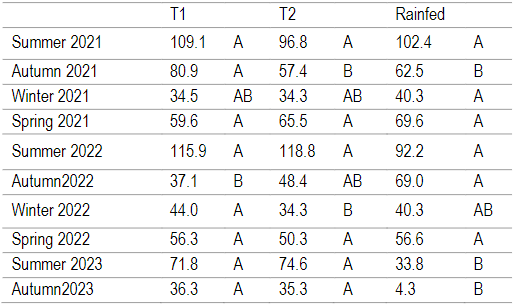
Different letters indicate significant differences between treatment means (Pr>|t|) using a p-value of 0.05 and Bonferroni correction.
The highest growth rates were observed in the summer, followed by the spring. However, there are no differences between spring and autumn, and the lowest growth rates occur in winter.
3.2.2 Grazing frequency
During the evaluation period, 24 grazing events were carried out in T1 and T2, with summer and spring presenting up to 3 grazing events, while 20 total grazing events were conducted in the rainfed treatment. The difference occurred in the last summer and autumn, where only one grazing was carried out in each season due to the low production of dry matter in the rainfed area.
3.3 Water balance
A water balance was conducted by treatment for irrigation management. The figure below shows the water balance for the three treatments in the last season from spring 2022 to autumn 2023, which was characterized as the driest in the last 36 years (Figure 2). It can be observed that the irrigations applied in T1 allowed the soil moisture to remain around the established threshold (red line), but away from FC, except when rainfall occurred. In this same treatment, there were two specific delays in the irrigation applied in the second half of January 2023 and in March 2023, which were quickly reversed. The irrigations applied in T2 respected the depletion threshold (65%) and kept moisture below FC, except when rainfall greater than 40 mm occurred (124 mm on 14/11/2022; 48 mm on 20/03/2023). T0 (rainfed) reached the condition of permanent wilting point (PWP) at 50 cm depth from 03/01/2023 to 26/02, the day when a rainfall of 35 mm occurred. Although the crop did not die, because it was possibly absorbing water at greater depths, the DM yield was seriously affected in the summer and the following season (Figure 1), despite a series of rains in the autumn that reversed the condition of low water content in the soil. In summer 2022-23 and autumn 2023, DM ha-1 productivity was statistically significant in favor of irrigation; however, irrigated treatments did not differ from each other.
The following figure (Figure 3) shows the ETc, the adjusted ETc, the precipitation and the applied irrigations for the entire evaluation period. It can be observed that, in general, the total PP is higher than the ETc; however, given its magnitude and frequency, it was not fully effective, making it necessary to cover part of the ETc with irrigation. In the case of rainfed land, the adjusted ETc diverges from the ETc in summer due to the water stress caused by the low contribution of PP and the absence of irrigation. This situation occurs even in summers where PP exceeds ETc.
The third graph corresponding to the rainfed treatment shows the gap between the ETc and the adjusted ETc, which only occurs in summer. In the first two summers, the difference was 27% and in the last summer, it was 74%.
In T1, 52% of the ETc is covered by irrigation and the remaining 48% by PPef, while in T2, 41% corresponded to irrigation and 59% to PPef. Over the entire experimental period, spaced irrigation resulted in a saving of 235 mm (T2), 26% less compared to frequent irrigation (T1).
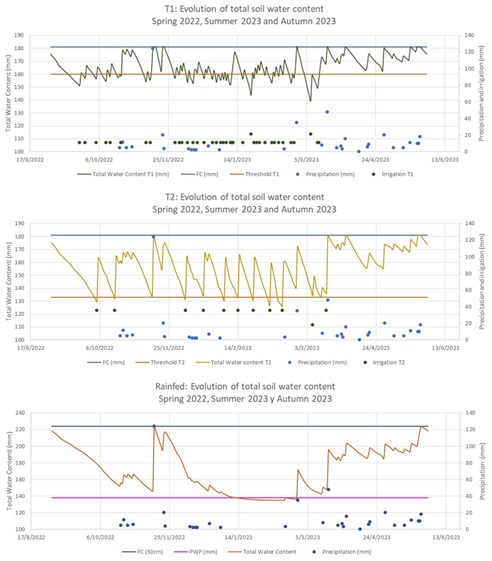
Figure 2: Evolution of total soil water content, precipitation (blue circles), irrigations (black circles), field capacity (FC), irrigation threshold (T1 and T2), and permanent wilting point (PWP) in rainfed treatment
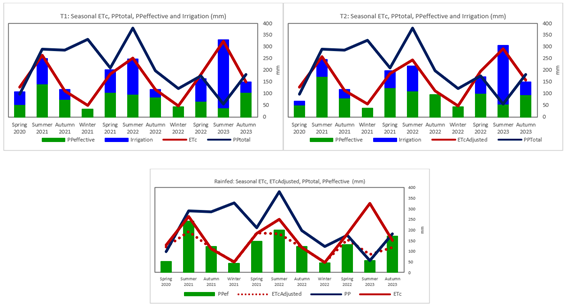
Figure 3: Crop Evapotranspiration (ETc), Adjusted Evapotranspiration (ETcadjusted), Total Precipitation (PPtotal), Effective Precipitation (PPeffective), and Seasonal Irrigations for the entire trial period (spring 2020 from October)
The management of different irrigation thresholds determined, as expected, a lower number of irrigations performed in T2 (spaced irrigation) (Table 5). This difference has important implications for pasture and irrigation management, operational costs, and the better use of rainfall. The following table shows the total water consumed by alfalfa at each treatment and season. This total water includes irrigation water, effective PP and water from soil storage (variation). The differences between T1 and T2 are due to the fact that in T2, on the days preceding irrigation, the soil water content depleted the AFD (Figure 2) and experienced mild water stress, that determines stomatal closure, reducing the crop's water consumption15.
The annual water consumption of alfalfa for T1 was 608 and 589 mm, for T2, 570 and 546 mm, and for rainfed 512 and 496 mm, in the first two years of evaluation. In the third year, the one with the lowest total PP, only in summer and autumn water consumption reached 464, 428 and 195 mm in T1, T2 and rainfed, respectively. In the period from spring 2022 to autumn 2023, the climatic characterization of the trial indicated it was an average year in terms of ETo, due to the fact that high ETo values corresponding to January and February were averaged, with low values in autumn.
3.4 Water productivity
Analysis of water productivity by season does not indicate a clear trend. In general, in the seasons where less irrigation was applied, rainfed and T2 had higher water productivity (WP). In the summer of 2022, T2 was significantly higher than T1 and rainfed, while in the summer of 2023, there were no differences between treatments. It is worth noting the low WP of the rainfed in autumn 2023 due to the effect of the summer water deficit. Although rainfall occurred during this season, it was scarce and did not allow for the recovery of alfalfa production levels.
It should be noted that despite there being no significant differences in the WP of the summer 2023 (the driest season), between irrigated and rainfed, the irrigated treatments had a pasture yield of 5889 kg DM ha-1, while rainfed reached 1361 kg DM ha-1 (Figure 1). This resulted in the possibility of carrying out two grazing events in irrigated areas against one in rainfed areas.
Table 6: Total water and irrigation water productivity (kg DM ha-1 mm-1)
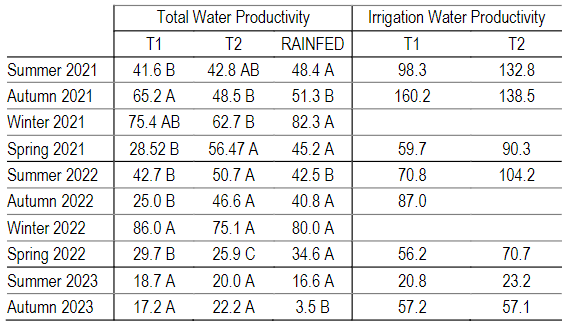
Different letters indicate significant differences between treatment means (Pr>|t|) using a p-value of 0.05 and Bonferroni correction.
Higher WP in T2 or the lack of difference with T1 would indicate better performance of this treatment, as it is possible to achieve high pasture yields with less irrigation water. When observing the irrigation WP (Table 5) in most seasons, T2 has values above T1, indicating the convenience of this treatment, T2 over T1. Considering that the difference between irrigated treatments is based on two levels of depletion (30 and 65%), this determines not only different irrigation frequencies and fewer irrigations but also differential irrigation water volumes. As mentioned above, over the entire experimental period, spaced irrigation (T2) implied a saving of 235 mm, 26% less. Making an analogy with pivot irrigation, this would mean 33 fewer irrigations (for a 7-mm pivot), equivalent to 660 hours of pumping. It is important to consider these aspects as they affect irrigation operations and costs.
3.5 Water function: Dry matter yield
The dry matter yield function indicates the increase in dry matter or biomass that is achieved by increasing the water consumption of the crop.

Figure 4: Dry matter yield (kg DM ha-1) as a function of crop water consumption (mm). For the first two years in dotted line and for the third year in continuous online
In the first two years of cultivation, each mm of water received by alfalfa increased the yield by 48 kg DM ha-1. Water accounted for 88% of the variation in DM ha-1 yield and from 516 mm there would be no increase in productivity, with a maximum of 24.5 t DM ha-1. However, in the third year of cultivation, the response to irrigation decreased (23.2 t DM ha-1) and so did the critical level from which there is no response (427 mm, with a maximum of 8 t DM ha-1). Water accounted for 89% of the variation in DM ha-1 yield. These results suggest the convenience of supplementary irrigation during the first two years, even in productive systems with grazing, but not in the third year, where the response in DM yield dropped drastically.
3.6 Effect of irrigation and grazing on soil bulk density and carbon content
Soil bulk density (DAp) was evaluated in each year of the experiment (Table 7). The statistical analysis indicates a significant increase (p > 0.05) of the DAp from the establishment of the pasture until the end of the experiment, increasing over the years in all treatments with no differences between them. T2 differed significantly from rainfed treatment only in the last year. With the incorporation of animals, the bulk density tends to increase, but there is no significant difference between the two evaluated irrigation management practices.
Table 7: Bulk density (DAp) values, treatment-adjusted means and standard error (SE) by sampling date, for a depth of 10 cm
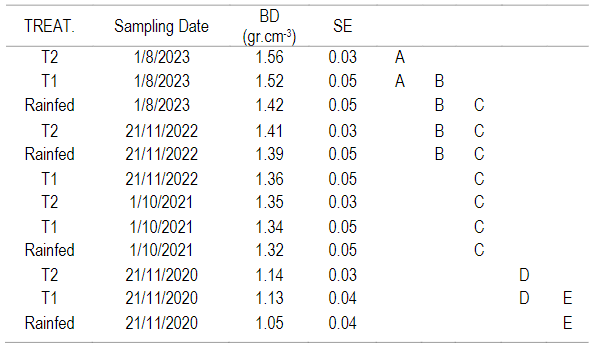
Means with the same letter are not significantly different (p > 0.05)
Regarding the carbon content of the soil, an analysis was conducted to assess the variation occurring between the beginning of the experiment and at 5 and 36 months (end of the experiment). In both cases, there were no significant differences between treatments. In the analysis of the percentage of carbon at the end of the third year of evaluation, no significant differences were found between treatments, with an average of 2.5% in rainfed and 2.25% in T1 and T2.
4. Discussion
The yields obtained in this study are similar to those observed in Catamarca (Argentina) under irrigation conditions with similar thresholds to those used in this experiment5. Russelle22 also reported similar yields in yield evaluation trials (small plots) in the United States, both under rainfed and irrigated conditions. This same researcher, analyzing agricultural census data, reported commercial rainfed alfalfa productions of 20 t DM ha-1 and 25 t DM ha-1 with irrigation. At the local level, a background review of pasture irrigation indicated lower yields for alfalfa cv.Crioula, around 14 t DM ha-1 with irrigation and 8.5 t DM ha-1 in rainfed conditions23. The high yields achieved under rainfed conditions (T0) are possibly due to a greater soil exploration capacity of the alfalfa at the experimental site, and thus, the ability to extract water from greater depths19.
Growth rates were similar between treatments, leading to no significant differences in annual yields among the evaluated treatments (Table 2). There was only a significant difference in the growth rate in the last summer and autumn, caused by severe water stress in the rainfed treatment, which resulted in higher yields in T1 and T2. Otero & Castro24 reported similar trends; however, the growth rate values mentioned by these authors, 39, 19, 40 and 54 kg DM ha-1 day-1 for autumn, winter, spring and summer, respectively, were lower than those obtained in this study.
Seasonal water productivity was lower or equal in T1 compared to T2 and/or rainfed, indicating that frequent irrigation (T1) can increase yields, but this increase is not efficient, as each millimeter applied produces less DM. This makes such management counterproductive both environmentally and economically, as it involves higher water, energy, and production costs. Irrigation water use efficiency confirms this trend, as in almost all irrigation situations (except autumn 2021), T2 had higher water productivity.
Sawchick and others23 indicated water use efficiencies of 35 kg DM mm-1 and found no significant differences between irrigated and rainfed conditions in wet years; they also reported that in years with high demand, the greatest response to irrigation was associated with high growth rates. As a negative effect of irrigation, these authors mention an increase in the percentage of plants affected by wet root rot (Phytophtora).
The total water consumption throughout the experimental period was on average 1600 mm for T1 and T2, while the rainfed area consumed 1203 mm. On an annual basis, T1 consumed 599 mm, T2 558 mm, and the rainfed 504 mm. On the other hand, López and others25 estimated a water consumption of 1464 mm year-1 for a forage production of 28 t DM ha-1 year-1 in two alfalfa varieties in a trial without water constraints carried out in Córdoba (Argentina) over three seasons. According to Sheaffer and others2, these values fall within the range of alfalfa water consumption, which is between 400 and 1800 mm ha-1 year-1.
Regarding dry matter productivity, although the annual differences are not clearly defined in favor of irrigation, the analysis of seasonal data indicates the convenience of irrigating alfalfa in the summer months, since in this season, irrigation implied an increase of 43% in the second summer and 4.3 times more in the third summer. Additionally, as a result of the extreme summer that occurred, in autumn 2023, irrigated treatments yielded 7 times more than rainfed, despite the fact that the precipitation corresponding to this season (autumn 2023) totaled 181 mm, very well distributed over 16 events. However, the yields achieved were lower than in previous years, possibly due to the high temperatures during the summer months and the cumulative effect of grazing on pasture persistence. While alfalfa thrives under different environmental conditions and adapts to a wide variety of climates and altitudes24, thermal stress is one of the main factors limiting its expansion in certain regions. Mainly, high temperatures can halt growth and reduce pasture yield and persistence9. In this study, in the last summer evaluated, there was a greater number of days with maximum temperatures above 30 °C, potentially affecting alfalfa productivity, even under on-demand irrigation conditions. In this regard, it should be noted that in the third summer, there were 16 days with maximum temperatures between 35 and 41 °C, while in the other two years of evaluation, the number of days that presented that range of maximum temperatures was 7 days and 1 day, for 2021-22 and 2020-21, respectively.
Regarding soil bulk density, a possible explanation for the lower DAp values in the rainfed treatment is that there were fewer grazing events in that last year (2 vs. 6), due to lower forage production caused by drought. In this experiment, and depending on the management of irrigation and pasture, there was no negative effect (soil compaction) attributable to irrigation management, since in general there were no significant differences between irrigation treatments (T1 and T2) and it was only significant when the number of grazing events increased compared to rainfed pastures. This effect of grazing on the increase of soil DAp has been mentioned by other researchers 10)(11) .
5. Conclusions
Under the irrigation and grazing conditions established in this experiment, alfalfa responded significantly to irrigation in the summer months with higher dry matter productivity. Irrigation management by water balance with the thresholds evaluated in this study did not affect dry matter productivity. However, spaced irrigation management, allowing a 65% depletion of total available water, determined a 26% irrigation saving compared to frequent irrigation management, allowing a 30% depletion of total available water.
Irrigation requirements for the summer ranged from 71 mm for an average year to 249 mm for dry years for spaced irrigation management, with a threshold of 65% total available water depletion; while for frequent irrigation with a threshold of 30% total available water depletion, requirements ranged from 107 mm to 289 mm for average and dry years, respectively.
In periods with scarce or no rainfall, dry matter productivity in rainfed areas dropped significantly and affected pasture productivity in the following season, with values up to seven times lower than in irrigated treatments, even when rainfall is restored. The bulk density of the soil increases over the years of the pasture but is not affected by the evaluated irrigation management.
As a final recommendation, alfalfa should be supplemented with irrigation in the summer months, defining the irrigation times based on a water balance in the depth of the absorbent roots, allowing for the maximum depletion of the available water evaluated in this study and applying irrigation sheets that do not return the soil to field capacity. In this way, the possibility of capturing rainfall increases, enhancing its effectiveness, and saving water and energy allocated for irrigation.

















